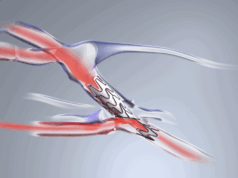
Robert Shahverdyan (Hamburg, Germany) writes for Vascular News on the technologies shaping the future of the field of percutaneous arteriovenous fistula (AVF) creation for patients requiring haemodialysis, following his recent address at the 2025 Leipzig Interventional Course (LINC 2025; 28–30 January, Leipzig, Germany) on the same topic.
The creation of vascular access is a critical step for patients requiring haemodialysis, and traditionally, surgical arteriovenous fistulae (AVFs) have been the gold standard. However, the introduction of percutaneous arteriovenous fistulae (pAVFs) in 2017 marked a significant advancement in this field. The concept of pAVFs was revolutionary because it allowed for the creation of vascular access using endovascular techniques rather than open surgery. These minimally invasive procedures promised to create an AVF without the need for surgical incisions, reducing trauma and improving patient outcomes. Two devices received FDA and CE-approval and became commercially available: WavelinQ (BD) and Ellipsys (Medtronic). These devices use different mechanisms to create the AVF, both utilising catheter-based systems to connect an artery and a vein under imaging guidance.
Upon introduction, pAVFs generated significant excitement in the medical community. The promise of avoiding surgical trauma while achieving durable results led to increased usage, especially among early adopters and specialised centres. Clinicians saw potential benefits, including reduced wound infection and AVF-failure risks, faster healing, and preservation of additional access sites for future procedures. But despite the early enthusiasm, pAVFs failed to achieve widespread adoption worldwide. Additionally, over the past two to three years, the initial momentum surrounding pAVFs has slowed, with a noticeable decrease in usage. Many centres that initially adopted the technology either reduced their procedural volume or abandoned it altogether. As a result, only a few highly experienced specialists remain who continue to use WavelinQ, Ellipsys, or both.
Why? One of the primary challenges with early pAVF technology stems from the location where these fistulas are created. Unlike traditional surgical AVFs, current generation pAVFs are created in or adjacent to the deep veins, leading a significant portion of the fistula flow to return through the deep venous system instead of being directed efficiently to the superficial veins. This results in fractional flow loss due to multiple venous branches. As a result, in many dialysis centres cannulation of pAVFs can be difficult. Although this has (partially successfully) led to increased reliance on and adoption of ultrasound guidance for cannulations, longer learning curves for dialysis staff to adapt to pAVFs are necessary and many are reluctant to do that.
Another challenge is the development of juxtaanastomotic venous stenosis. This can compromise fistula maturation and delay usability for dialysis, as well as increase the risk of access failure, requiring frequent interventions to maintain patency and ensure the fistula is functional for dialysis. Hence, many patients require additional (typically interventional) procedures before successful cannulation.
The combination of device costs, procedural expenses, and the need for frequent reinterventions has made pAVFs more expensive compared to traditional surgical AVFs. While there is no large direct cost-effectiveness comparison yet with mixed reports, and pAVFs offer advantages in many patients, the overall financial burden remains a significant barrier to widespread adoption. Therefore, to increase the pAVF adoption, pAVF-devices should be cheaper to reduce the costs of the initial procedure, yet improve pAVF outcomes by reducing number of interventions, hence additionally reduce follow-up expenses. More importantly, the high rate of unassisted maturation would improve usability while minimising hospitalisation costs. Finally, if the procedure is both fast and successful, it would enhance overall efficiency in patient care.
To address the above challenges, several pAVF-devices are being developed, of which two: ePATH (Pathfinder Medical, UK) and Velocity (Venova Medical, USA) are known through several conferences. The ePATH is an electronic guidance system, which employs an ultra-low profile catheter system to enable precise placement and positioning of guidewires and catheters using a re-entry and endovascular bypass (presumably a stentgraft) techniques, with an AVF-creation at the wrist under fluoroscopic imaging guidance. Although this device can add new anatomical locations for pAVF-creation, many uncertainties remain, specifically regarding the technical success and patency of the small and sharp (c-shaped) angled implant, covering the distal radial artery. Limited information is available on this system except that there have been successful animal and cadaveric studies.
Velocity aims to “streamline” the AVF-creation process, enabling rapid functionality with reduced need for reinterventions, thereby addressing patient and systemic barriers associated with current methods. It is designed for optimal flow dynamics, featuring a single outflow using a covered tapered fenestrated implant through the perforating vein into the proximal radial artery without the need for flow diversion or embolization, which promotes fast maturation. Its advanced approach should minimise anastomotic stenosis by avoiding inflammation, thermal injury, and turbulent flow, eliminating the need for angioplasty. Additionally, it should allow procedures to be performed even faster than the current pAVF-procedures and under ultrasound guidance, making it a practical and efficient option for both patients and clinicians. Recent clinical experience, such as from the VENOS-1 FIH [first-in-human] trial, has demonstrated the potential to improve unassisted maturation and primary patency rates and decrease complications, positioning it as a promising alternative in vascular access management. The US-feasibility study (VENOS-2) has been initiated in January 2025 and will hopefully confirm the excellent outcomes of the FIH-trial.
Whether the mid- to long-term outcomes and device costs of next-generation pAVFs become favourable, and the Velocity device becomes an “ideal” pAVF-system, remains to be evaluated in future years.
Disclosures: Robert Shahverdyan is a consultant for Medtronic, BD, Laminate Medical, Xeltis and VentureMed, has been in receipt of honorarium from Cardionovum and BrosMed Medical, and is on the scientific advisory board of Venova Medical.













